Future of the Royal Air Force
The planning for the future of the Royal Air Force involves supporting ongoing British military operations,[1] the introduction of new aircraft types,[2] greater focus on network enabled capability and increasing interoperability with members of NATO.[1]
Combat Air
F-35 Lightning II
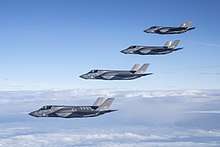
The Lockheed Martin F-35 Lightning II is a family of single-seat, single-engine, fifth generation multirole fighters under development to perform ground attack, reconnaissance, and air defence missions with stealth capability. It was selected for the UK's Joint Combat Aircraft requirement in 2001 and is expected to enter service with the Royal Navy and the RAF from around 2020, having been selected initially to replace the Royal Navy's BAE Sea Harrier fighter, and latterly the existing Panavia Tornado GR.4 and Harrier GR.9 fleets (the latter already having been retired in late 2010), operating principally from the Queen Elizabeth-class aircraft carriers.[3] It will be the main component of the RAF's manned strike capability, and marks the return of a carrier-borne strike capability for the Fleet Air Arm for the first time in nearly a decade.
The version initially selected was the Short Take Off Vertical Landing (STOVL) variant of the F-35, known as the F-35B. However, on 19 October 2010, David Cameron announced that the UK would change their order to the F-35C CATOBAR carrier variant for both the RAF and Navy. The F-35C variant features larger wings with folding wingtips and larger wing and tail control surfaces for improved low-speed control. This gives it a greater range and the ability to carry a larger and more diverse payload than the F-35B.[4]
In May 2012, it was announced that the government had reverted to the previous plan to operate the STOVL F-35B, due to rising estimated shipbuilding costs associated with the CATOBAR variant F-35C, and an earlier estimated in-service date for the F-35B.[5]
The delivery of the UK's first F-35B was made on 19 July 2012 at Fort Worth, Texas, for flight trials by the RAF and Royal Navy.[6]
In 2015, the government's Strategic Defence and Security Review confirmed a planned order of 138 F-35s, with 24 of them to be available for carrier duties by 2023.[7][8] On 10 January 2019, initial operating capability for the UK's F-35B was announced.[9] The UK is committed to improving its F-35Bs to Block 4 standard, however, the actual number of improved jets is yet to be known.[10][11]
The F-35 Lightning units of the RAF and the Fleet Air Arm will be organised under a single administrative structure called the Lightning Force, which will form part of RAF Air Command.
Current and future units
- No. 617 Squadron RAF, RAF Marham
- Unnamed Royal Air Force Squadron
Operational Conversion Units
Operational Evaluation Units
Typhoon
It was announced in the 2015 Strategic Defence and Security Review that the Royal Air Force would retain its Tranche 1 Typhoons and use them to stand up an additional two squadrons. It was also announced that the aircraft would remain in service until 2040, ten years longer than previously planned.[8] The Government also promised to invest further in Typhoon air-to-ground capabilities and in a new active electronically scanned array (AESA) radar, as well as completing integration of the Storm Shadow and Brimstone missiles with the Typhoon. 107 Tranche 2 and 3 Typhoons will be equipped via "Project Centurion", allowing them to launch Meteor missiles, Brimstone and Storm Shadow missiles. 24 Tranche 1 Typhoons will be retained for UK Quick Reaction Alert purposes.[14] The final aircraft of the 160 ordered is due to be handed over in August 2019.[15]
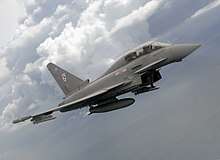
Frontline Units
- 1(F) Squadron, RAF Lossiemouth
- 2(AC) Squadron, RAF Lossiemouth
- 3(F) Squadron, RAF Coningsby
- 6 Squadron, RAF Lossiemouth
- IX(B) Squadron, RAF Lossiemouth
- XI Squadron, RAF Coningsby
- 12 Squadron,[16] RAF Coningsby
- 1435 Flight, RAF Mount Pleasant
Operational Conversion Units
Operational Evaluation Units
Combat Air Strategy and Team Tempest
At the 2018 Farnborough Airshow, UK Defence Secretary Gavin Williamson announced Team Tempest, a joint program office consisting of government divisions alongside BAE Systems, Leonardo, MBDA and Rolls-Royce would be developing a new design of fighter aircraft with UK£2 billion (US$2.6 billion) in funding, by 2025.[17] This will develop new technologies and means of production under the Future Combat Air System Technology Initiative (FCAS TI)). It is likely to involve technology from Italy and Sweden using Gripen E, and is also likely to leverage on the UK's Eurofighter Typhoon experience.[18]
Patrol
Poseidon
.jpg)
One of the most anticipated announcements in the Strategic Defence and Security Review 2015 was the purchase of a maritime patrol aircraft to replace the capability lost after the cancellation of the Nimrod MRA.4 in 2010. The review announced that the UK planned to acquire nine Boeing P-8 Poseidon aircraft, which would be based at RAF Lossiemouth in Scotland by 2025.[8] The aircraft will include an "overland surveillance capability", which could eventually replace the surveillance capability lost by the retirement of the Sentinel R1 in 2025. The RAF plans to operate its P-8s with U.S. weapons such as MK54 torpedoes and Harpoon anti-ship missiles initially, with a possible transition onto British weapons in the future.[19][20]
Current & Future Units
- 120 Squadron, RAF Lossiemouth (first P-8 Poseidon unit)
- 201 Squadron (standing up in 2021)
Wedgetail
.jpg)
In 2018, the RAF announced plans to upgrade its airborne early warning facility. Initially this was planned as an upgrade of the E-3D Sentry fleet, which would mirror the Sentry Block 40/45 upgrade undertaken by the USAF, and subsequently fitted to the Sentry fleet of the Armée de l'Air in France. However, owing to the significant cost of such a project, estimated at approximately £2 billion, it was thought that it would be more cost-effective to procure a new system instead.[21] Although there were calls for an open competition to select the new platform, most notably from a partnership between Airbus and Saab, which would feature the Swedish company's Erieye radar system combined with an Airbus aircraft, the Ministry of Defence was announced as being in talks with Boeing over procuring its E-7 Wedgetail aircraft.[22][23] To this end, in August 2018 the RAF began sending personnel to Australia to undergo training on the E-7, which was already in service with the RAAF.[24] The potential selection of the E-7 was seen as advantageous in part due to its level of commonality with the P-8 Poseidon, which the RAF had selected as its new maritime patrol aircraft, as well as enabling greater co-operation with the RAAF.[25] In October 2018, the Defence Secretary, Gavin Williamson, announced that the Government had begun negotiations with Boeing, having determined that the E-7 "represents the best value for money option for the UK against need".[26] A deal was signed in March 2019 that will see the RAF procure five E-7 aircraft for approximately £1.5bn.[27]
Current & Future Units
Signals Intelligence
Rivet Joint
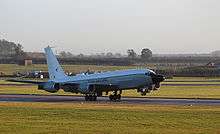
A total of three Boeing RC-135 Rivet Joint signals intelligence aircraft, ordered to replace the Nimrod R1 which was retired in 2011,[29] are now in service as of 2017.[30] These became known as Air Seeker when they entered RAF service in 2014.[31] The aircraft is an extensively modified Boeing C-135 Stratolifter with onboard sensors which enable the crew to detect, identify and geolocate signals throughout the electromagnetic spectrum. The crew can then forward information in a variety of formats to a wide range of consumers via the onboard secure communications suite.
Current Units
Operational Conversion Units
Sentinel R1
.jpg)
The 2015 Strategic Defence and Security Review announced that the Sentinel R1 would remain in service "until the next decade" with the intention that it be withdrawn by 2025.[32]
Current Units
Operational Conversion Units
Shadow R1
_Sqdn_RAF_Waddington_this_morning.jpg)
The 2015 Strategic Defence and Security Review stated that the Shadow R1 would remain in service until "at least" 2030. An additional two aircraft would also be procured for a total of eight in service by 2025.[8]
Current Units
Operational Conversion Units
Defender and Islander aircraft
A parliamentary statement in 2016 stated that the Defender and Islander fixed-wing aircraft will be transferred from the Army Air Corps (AAC) to the RAF.[33] This transfer was completed in April 2019. Personnel from 651 AAC will still initially be from the AAC but report to 1 Group RAF.[34]
Project Solomon
In 2004, the Royal Air Force initiated Project Dabinett, an integrated architecture to collect, process and disseminate intelligence from manned and unmanned aircraft such as Sentinel and Watchkeeper. Initial Gate was approved in January 2008; when assessment phase contracts were awarded to BAe INSYTE and Lockheed Martin UK. In February 2010, it had been renamed Project Solomon. Phase I concentrates on disseminating information over the UK Defence Information Infrastructure networks, with Initial Operating Capability in March 2012 and Full Operating Capability in March 2015.[35] There, however, has been no progress since then.
Transport and air-to-air refuelling
Atlas
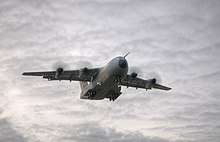
Future transport capability will rely on the Airbus A400M Atlas, of which 22 are to be used to replace the Lockheed Hercules C1/C3 (C-130K) aircraft.[3]
The Airbus A400M will increase the airlift capacity and range compared with the aircraft it was originally set to replace, the older versions of the Hercules and Transall. Cargo capacity is expected to double over existing aircraft, both in payload and volume, and range is increased substantially as well. The cargo box is 17.71 m long excluding ramp, 4.00 m wide, and 3.85 m high. The height is 4.00 m aft of the wing and the ramp is 5.40 m long. The Airbus A400M will operate in many configurations including cargo transport, troop transport, Medical evacuation, and electronic surveillance. The aircraft is intended for use on short, soft landing strips and for long-range, cargo transport flights.[36]
Current and future units
- 70 Squadron, RAF Brize Norton
- 30 Squadron, RAF Brize Norton (expected to be the second operational squadron following retirement of part of the Hercules fleet)
Operational Conversion Units
- 24 Squadron, RAF Brize Norton
Operational Evaluation Units
- 206 Squadron, RAF Brize Norton
Hercules
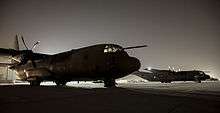
The Strategic Defence and Security Review 2015 included a reprieve for some of the Hercules fleet, with the Government announcing "We will upgrade and extend the life of our C130J aircraft, allowing them to support a range of operations until 2030".[8] It had been reported that the British Army's senior leadership was unhappy with the retirement of the Hercules aircraft, due to uncertainty regarding the A400M's and C-17's effectiveness in some tactical roles.[37] The 2015 Strategic Defence and Security Review envisioned a fleet of 14 C130J aircraft.[8] On 24 July 2019, it was reported the UK would extend the out of service date of the RAF's Hercules to 2035 in order to allow from the A400M to be rolled out. Due to one C-130J-30 being damaged beyond repair in June 2018, the RAF will retain 13 C-130J-30s and one C-130J in its inventory, selling the remaining C-130Js.[38]
Current units
- No. 47 Squadron RAF, RAF Brize Norton
Operational Conversion Units
- No. 24 Squadron RAF', RAF Brize Norton
Operational Evaluation Units
- No. 206 Squadron RAF, RAF Brize Norton
Helicopters
Chinook
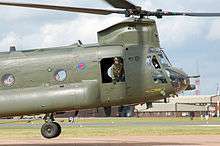
On 16 December 2009, the Ministry of Defence announced that 22 UK-specific Boeing Chinook helicopters would be added to the current Chinook fleet, bringing the total number in service to 70 by 2013. However, in 2010, the order was reduced to 14.[3] The new aircraft will enter service from late 2014 onwards. In 2006, the retirement dates for the HC2 and HC2A fleets were scheduled for 2015 and 2025, respectively, however with upgrades to a digital cockpit and digital automatic flight control system the types are expected to be flying until 2040.[41][42]
Current Units
- No. 7 Squadron RAF, RAF Odiham
- No. 18(B) Squadron, RAF Odiham
- No. 27 Squadron RAF, RAF Odiham
Operational Conversion Units
Puma
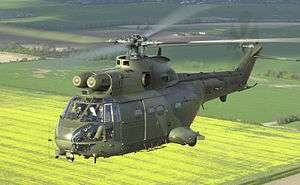
A total of 24 Aérospatiale Puma HC1s have been upgraded to HC2 standard to prolong their lives until 2025.[8]
Current Units
- No. 33 Squadron RAF, RAF Benson
- No. 230 Squadron RAF, RAF Benson
Operational Conversion Units
- No. 28 Squadron RAF, RAF Benson
Unmanned Aerial Vehicles
Protector RG.1
The Protector programme (formerly known as Scavenger) will supply a next-generation medium-altitude, long-endurance (MALE) UAV to replace the current General Atomics MQ-9 Reaper UAVs.[43] In June 2011, BAE Systems and Dassault Aviation would collaborate on an aircraft called Telemos.[44][45] However, the project was effectively abandoned in 2012 after Dassault pursued a collaboration with EADS Cassidian and Alenia Aermacchi instead.[46]
In October 2015, the Prime Minister, David Cameron, announced the purchase of more than 20 Protector UAVs which would be delivered by the end of the decade.[47][48] This was confirmed in the 2015 Strategic Defence and Security Review. As of mid-2018, the in-service date had slipped to 2024.[16] The exact platform selected for Protector was not disclosed, but in February 2016, General Atomics Aeronautical Systems claimed that it would be a Certifiable Predator B.[49]The Ministry of Defence later confirmed that it would be an enhanced variant of Predator B, designed to be compatible with NATO airworthiness standards, and that it would also come with the extended wing and fuel tanks of the ER (Extended Range) version, giving an increased endurance of over 40 hours.[50] In April 2016, the Ministry of Defence confirmed it would seek to acquire the Certifiable Predator B through a Foreign Military Sales contract with the U.S. Department of Defense.[51][52] It was indicated that at least 16 UAVs would be purchased with a maximum of up to 26. [53]In July 2018, it was announced that this aircraft will be designated Protector RG Mk 1 in RAF service, and is to be delivered in 2024 when it will replace Reaper.[54] A contract was signed on 11 September 2019 to test the RPAS' limit and report on its performance.[55] In July 2020, the Ministry of Defence signed a contract for three Protector UAVs with an option on an additional thirteen aircraft.[56] While additional Protector UAVs remained an option, this was reported as dependent on the outcome of the planned integrated defence and foreign policy review expected in 2021. [57]
According to MBDA, the Royal Air Force intends to arm the aircraft with Brimstone missiles and Raytheon UK Paveway IV precision-guided bombs.[58][59]
Future Units
- 31 Squadron (1st Protector RG.1 Operational Squadron will reform at RAF Waddington)[60]
- 13 Squadron (current MQ-9A Reaper Squadron, will convert to MQ-9B at RAF Waddington)
- 39 Squadron (current MQ-9A Reaper Squadron at Creech AFB (NV, USA), will reform & convert to MQ-9B at RAF Waddington)
Operational Conversion Unit
Test & Evaluation Unit
Zephyr
Leading up to the Strategic Defence and Security Review 2015, Prime Minister David Cameron announced that "British-designed unmanned aircraft will be constructed to fly at the very edge of the earth’s atmosphere and allow us to observe our adversaries for weeks on end, providing critical intelligence for our forces."[61] Gareth Jennings of IHS Jane's identified this as the solar-powered Qinetiq Zephyr.[62] The Ministry of Defence confirmed an initial order for two Zephyr aircraft in February 2016 for demonstration purposes.[63] In August 2016, the MOD confirmed a purchase of a third Zephyr.[64]
Swarming Drones
On 11 February 2019, Secretary of State for Defence Gavin Williamson announced that the UK will develop 'swarming drones' to defeat enemy air defences.[65] A IHS Janes report stated that the RAF will form a new squadron to specifically control these drones.[66]
Current Units
Lightweight Affordable Novel Combat Aircraft (LANCA) programme
The RAF's Rapid Capabilities Office is aiming for a technology demonstrator, named ‘Mosquito’, which three contracts placed with Blue Bear Systems Research Ltd, Boeing Defence UK Ltd, and Callen-Lenz (Team BLACKDAWN partnered with Bombardier Belfast and Northrop Grumman UK Ltd). This project is aiming for adding unnamed capabilities to future jet aircraft.[69] However, no such plan has been put forward since then.
Future Combat Air System (FCAS)
The Future Combat Air System (FCAS) (also known as the Unmanned Combat Air System (UCAS)) aimed to deliver an unmanned combat aerial vehicle (UCAV) by 2030.[70] FCAS will be built in co-operation with France, utilising technology from the BAE Taranis and Dassault nEUROn technology demonstrators.[70] Development of full-scale prototypes is expected to begin by 2017.[71] In the Royal Air Force, FCAS will be expected to operate alongside Typhoons and F-35 Lightning IIs.[72]
As a UCAV, FCAS will utilise stealth technology to reduce its radar cross-section (its radar signature is reportedly the size of a dragonfly).[73] It will feature a high degree of autonomy, enabling it to complete a large part of its missions without human control.[73] It will have a 16-metre (50 ft) wingspan and two internal weapon bays.[73]
According to Bernard Gray of the Ministry of Defence, technology from FCAS could also be incorporated onto a manned platform.[70] Other officials have also insisted that a manned option for FCAS has not been ruled out.[74] According to a House of Commons Defence Select Committee (DSC) report, a new "clean-sheet" manned fighter design has not been ruled out, nor has the option to buy further or upgrade existing aircraft.[75]
Space operations
The Secretary of State for Defence, Penny Mordaunt, announced at the Air & Space Power Conference on 17 July 2019 that a Team Artemis, a joint US-UK team will be formed to launch and research small military satellites and "launch a small satellite constellation within a year".[76] It was announced separately that No. 23 Squadron RAF would reform as Britain's first "space squadron responsible for day-to-day space command-and-control, including the flying of satellites".[77][78]
Future Units
Training
The training provided to Royal Air Force aircrew is evolving, through a shift towards contractor-provided training, and increasing use of simulators to supplement flying time. The aircraft currently in use are approaching the end of their working lives. To fund new aircraft, the training system is being outsourced to the private sector, over a 25-year Private Finance Initiative valued at £6 billion. The consortium running the new UK Military Flying Training System is a partnership between Lockheed Martin and Babcock International, is known as Ascent Flight Training. The current generation training aircraft will be replaced over the next few years:
| Training phase | Current | Replacement | Base |
|---|---|---|---|
| Basic Gliding Training | Grob Viking T.1 | None identified | RAF Syerston and various locations |
| Elementary Flying Training | Grob Tutor T.1 | Grob G 120TP | RAF Cranwell, RAF Wittering |
| Basic Fast Jet Training | Short Tucano T.1 | Beechcraft T-6 Texan II | RAF Linton-on-Ouse |
| Advanced Fast Jet Training | BAE Hawk T.1/T.2 | BAE Hawk T.2 | RAF Valley |
| Multi-Engine Training | Beechcraft King Air | Embraer Phenom 100 | RAF Cranwell |
| Basic Helicopter Flying Training | Eurocopter Squirrel HT.1 | Airbus Helicopters H135 | RAF Shawbury |
| Advanced Helicopter Flying Training | Bell Griffin HT.1 | Airbus Helicopters H145 | RAF Shawbury |
Missiles
- The Royal Air Force has signed a contract to receive the Meteor BVRAAM missile for its tranche 2 and 3 Typhoons and future F-35 Lightning IIs. It will replace the AMRAAMs currently in service except for the tranche 1 Typhoons as they are not able to use it. It will be fitted on the Eurofighter Typhoon by the end of 2018 and the F-35B in 2024.[79][80][81]
- The 2015 Strategic Defence and Security Review announced further investment into the Storm Shadow and Brimstone missiles.[8]
- In March 2016, the Ministry of Defence extended the assessment phase contract for the Select Precision Effects At Range (SPEAR 3) missile programme, which aims to deliver a "mini-cruise missile" capable of attacking stationary and moving targets.[82]
- At the 2019 Chief of the Air Staff's Air & Space Power Conference (ASPC), it was announced that the RAF and MOD are pursuing Mach 5 air-to-air weapons capability or hypersonic missiles carried by Fourth-generation jet fighters, Fifth-generation jet fighters and Sixth-generation jet fighters.[83]
Countermeasures
- In September 2016, an initial £2.5m batch order for the British-developed BriteCloud DRFM jammer was placed with Leonardo-Finmeccanica. If trials of the system prove successful, it could begin to be fitted to the Royal Air Force's fast-jet fleet by mid-2017.[84]
Others
No. 601 Squadron, Royal Auxiliary Air Force will reform to "[tap] into the talents of leaders from industry, academia and research to advise and shape and inspire [the RAF]".[85]
No. 616 Squadron, Royal Auxiliary Air Force will continue to provide former regular RAF specialist & aircrew personnel to augment the front line ISTAR and Combat air Units.[86]
See also
- Future of the British Army (Army 2020)
- Future of the Royal Navy
- List of active United Kingdom military aircraft
References
- "Strategy". Royal Air Force. 2011. Retrieved 20 April 2011.
- "Future Capability". Royal Air Force. 2011. Retrieved 20 April 2011.
- Wall, Robert."U.K. Cuts Aircraft Fleets in Strategic Review". Aviation Week, 19 October 2010.
- Wilson, Amy (10 November 2010). "Babcock says Aircraft carrier changes will add up to £800m to taxpayer bill". The Daily Telegraph. London.
- "U.K. Makes F-35 U-Turn to Cut Costs, Narrow Carrier-Defense Gap." Bloomberg News, 10 May 2012.
- "UK Takes Delivery Of First F-35 Lightning II Jet". BAE Systems Newsroom. 19 July 2012.
- "Osborne: UK to speed up aircraft carrier jet purchase". BBC News. 22 November 2015. Retrieved 22 November 2015.
- "The National Security Strategy and Strategic Defence and Security Review 2015: A Secure and Prosperous United Kingdom" (PDF). gov.uk. Her Majesty's Government. Retrieved 24 November 2015.
- "UK declares IOC Land for F-35 force". IHS Janes. 11 January 2019. Retrieved 11 January 2019.
- "Ministry of Defence Joint Strike Fighter Aircraft". Hansard Ministry of Defence Written Questions and Answers. UK Hansard. Retrieved 26 June 2020.
The F-35 Block 4 upgrade has been included in the UK F-35 programme budget since its inception. Decisions on the number of aircraft to be upgraded will be made on the basis of military capability requirements.
- Trevithick, Joseph (24 June 2020). "British Government Says It Might Pass On $27M Upgrade For Some Of Its F-35s". The Warzone. Retrieved 26 June 2020.
- "Identity of F-35 Lightning Training Squadron Announced". RAF. 6 July 2017. Archived from the original on 28 July 2017. Retrieved 6 July 2017.
- "UK Planning four front-line F-35 Squadrons". Aviationweek. 20 May 2016.
- "RAF flies Meteor BVRAAM on Typhoon for first time". Janes.com. Janes 360. Retrieved 11 December 2018.
- "Royal Air Force Typhoon jets to receive key sensor upgrade". C4ISRNet. Retrieved 9 August 2019.
- Jennings, Gareth. "RAF announces new Typhoon, Protector squadrons". Jane's 360. Janes. Retrieved 15 July 2018.
- "Combat Air Strategy: An ambitious vision for the future" (PDF). gov.uk. 16 July 2018. Retrieved 12 February 2019.
- Britain reveals combat air strategy alongside new Tempest fighter jet design, Beth Stevenson, DefenseNews, 2018-07-16
- "US, UK Still Discussing Anti-Sub Gap Options". Defense News. 19 April 2016. Retrieved 19 April 2016.
- "UBoeing Poseidon contract includes first UK aircraft". IHS Janes. 4 April 2017. Retrieved 4 May 2017.
- Allison, George (23 March 2018). "'Range of options being explored' to replace British E-3 Sentry fleet". UK Defence Journal. Retrieved 3 October 2018.
- Chuter, Andrew; Stevenson, Beth (5 July 2018). "Airbus and Saab consider challenge to Boeing Wedgetail for UK". Defense News. Retrieved 3 October 2018.
- Reim, Garrett (3 October 2018). "UK in talks to buy Boeing E-7 Wedgetail Early Warning and Control aircraft". Flight Global. Retrieved 3 October 2018.
- Pittaway, Nigel (16 August 2018). "UK moves closer to Wedgetail buy". Australian Defence Magazine. Retrieved 3 October 2018.
- Trevithick, Joseph (3 October 2018). "U.K. Could Hand Deal Straight To Boeing For New Royal Air Force E-7 Radar Planes". The Drive. Retrieved 3 October 2018.
- Allison, George (4 October 2018). "Defence Secretary announces negotiations to purchase E-7 Wedgetail". UK Defence Journal. Retrieved 4 October 2018.
- Allison, George (22 March 2019). "UK purchases five Boeing E-7 early warning aircraft". UK Defence Journal. Retrieved 22 March 2019.
- Jennings, Gareth (17 July 2019). "RAF announces AEW&C, space, 'drone' test squadrons". IHS Janes. Retrieved 18 July 2019.
- "Nimrod R1 retires from service". Equipment and Logistics. Ministry of Defence. 7 July 2011. Retrieved 29 June 2012.
- https://ukdefencejournal.org.uk/uk-takes-delivery-third-final-rc-135-rivet-joint/
- Hoyle, Craig (14 January 2011). "RAF personnel start Rivet Joint training". Flight International. Retrieved 31 January 2011.
- "HomeNewsCentury Of Sorties For Raf Airseeker And Sentinel". Royal Air Force. 25 November 2015. Retrieved 24 November 2015.
- Harriett Baldwin. "Army Air Corps:Written question - 46689". Hansard House of Commons. UK Parliament. Retrieved 2 January 2020.
- Jennings, Gareth (2 April 2019). "UK transfers Defender and Islander special mission aircraft from AAC to RAF". IHS Janes. London. Retrieved 2 January 2020.
- "The contribution of ISTAR to operations: Government response to the Committee's Eighth Report of Session 2009–10" (pdf). UK Parliament. 27 July 2010.
- "A400M Capabilities". Airbus Military. Archived from the original on 7 September 2011. Retrieved 15 May 2010.
- Giannangeli, Marco. "SAS fight to keep Hercules planes". Express.co.uk. The Daily Express. Retrieved 24 November 2015.
- Jennings, Gareth (24 July 2019). "UK extends Hercules out-of-service date to 2035". IHS Janes. London. Retrieved 12 August 2019.
- https://www.airtanker.co.uk/news-centre/news-item/2016/07/14/delivery-of-the-final-voyager
- "David Cameron to get own plane for official trips". BBC News. 25 November 2015. Retrieved 19 November 2015.
- Hoyle, Craig (12 February 2006). "Boeing lifts massive UK Chinook deal". Flight International.
- "RAF Aircraft: Chinook HC2". armedforces.co.uk. Retrieved 29 March 2010.
- Putrich, Gayle (22 July 2010). "Farnborough: General Atomics says Avenger ready for RAF". Farnborough.
- Wall, Robert (8 June 2011). "BAE Systems, Dassault Name Joint UAV Effort". Aviation Week.
- Vandewalle, Yves; VIOLLET, Jean-Claude. "Rapport d'information déposé en application de l'article 145 du Règlement par la Commission de la Défense Nationale et des Forces Armées sur les drones". Assemblée Nationale. p. 57.
- "France and Britain Make Progress with Two Out of Three UAVs". AINonline. 27 July 2012. Retrieved 21 March 2016.
- "New investment in counter terrorism for UK Armed Forces". Ministry of Defence. 4 October 2015. Retrieved 21 March 2016.
- Dominiczak, Peter (3 October 2015). "David Cameron promises to 'beef up' the SAS to take the fight to Isil". Retrieved 21 March 2016.
- "General Atomics Eyes Asia Pacific Region for Popular Predator B". AIN Online. 13 February 2016. Retrieved 21 March 2016.
- "Protector = Scavenger". Royal Aeronautical Society. 9 October 2016. Archived from the original on 1 June 2016. Retrieved 23 March 2016.
- "Justification of the decision of the procurer to award the contract without the prior publication of a contract notice". HM Government. 24 April 2016. Retrieved 26 April 2016.
- "UK To Buy "Certifiable Predator B"". Aerossurance. 25 April 2016. Retrieved 26 April 2016.
- https://www.flightglobal.com/civil-uavs/us-approves-sale-of-up-to-26-protector-uavs-to-uk/122336.article
- Allison, George (18 June 2019), UK signs £72.5m contract for MQ-9A Reaper support to 2021, UK Defence Journal, retrieved 19 June 2019
- "£100m boost for cutting-edge Protector aircraft". Ministry of Defence UK. London. 11 September 2019. Retrieved 11 September 2019.
- "MOD signs £65 million contract for Protector aircraft". UK Ministry of Defence. London. 15 July 2020. Retrieved 16 July 2020.
- https://www.defensenews.com/global/europe/2020/07/15/uk-orders-first-three-protector-drones-from-general-atomics/?utm_source=clavis
- "Brimstone Reaper integration still in the pipeline". Flightglobal. 18 March 2016. Retrieved 21 March 2016.
- https://www.flightglobal.com/military-uavs/uk-signs-65m-contract-for-first-three-protectors/139302.article
- https://www.gov.uk/government/news/waddington-to-operate-protector-with-best-of-british-air-power-on-show-at-air-tattoo
- "David Cameron: We will defeat terrorism, and the poisonous ideology that fuels it". Telegraph. 22 November 2016. Retrieved 22 March 2016.
- "SDSR 2015: UK prime minister confirms plans to field 'near space' UAV, likely Zephyr". IHS Jane's. 23 November 2016. Retrieved 22 March 2016.
- "MoD to buy high-flying solar planes". BBC News. 2 February 2016. Retrieved 23 March 2016.
- "MOD buys third record-breaking UAV". UK MOD. 17 August 2016. Retrieved 17 August 2016.
- "Defence in Global Britain". UK Ministry of Defence. 11 February 2019.
- "UK to use 'swarming drones' to defeat enemy air defences". IHS Janes. 11 February 2019.
- Jennings, Gareth (17 July 2019). "RAF announces AEW&C, space, 'drone' test squadrons". IHS Janes. London and William Lloyd, London. Retrieved 18 July 2019.
- Jennings, Gareth (31 March 2020). "UK stands-up 'swarming drones' development unit". IHS Janes. London. Retrieved 2 April 2020.
- "DEFENCE MINISTER PRAISES UK'S "CUTTING-EDGE AIR POWER"". Royal Air Force. London. 19 July 2019. Retrieved 20 July 2019.
- "ANALYSIS: Anglo-French FCAS feasibility study kicks off". Flightglobal. 6 November 2014. Retrieved 22 March 2016.
- "New $2.2 billion Anglo-French FCAS phase announced". Flightglobal. 8 March 2016. Retrieved 22 March 2016.
- "BAE Says Drone Warplanes to Aid Fighter Pilots, Not Replace Them". Bloomberg Technology. 10 June 2016. Retrieved 10 June 2016.
- "Meet the Drone That Carries Out the Airstrikes Before the Airstrikes". VICE. 19 June 2016. Retrieved 22 March 2016.
- "Anglo-French FCAS May Not Be Unmanned". AIN. 12 November 2016. Retrieved 22 March 2016.
- "UK Sets Out post-2030 Combat Aviation Force Plans". UAS Vision. 19 June 2016. Retrieved 3 April 2016.
- "Defence Secretary keynote speech at the Air and Space Power Conference 2019". UK Ministry of Defence. London. 18 July 2019. Retrieved 18 July 2019.
- Jennings, Gareth (17 July 2019). "RAF announces AEW&C, space, 'drone' test squadrons". IHS Janes. London. Retrieved 18 July 2019.
- Chuter, Andrew (15 January 2020). "Former fighter pilot picked to lead British military's space command". DefenseNews. Gannett. Retrieved 10 April 2020.
- https://www.gov.uk/government/news/raf-typhoons-to-get-weapons-upgrade
- http://www.raf.mod.uk/newsweather/index.cfm?storyid=C68ABE90-1143-EC82-2EA56BEB107606D1
- https://www.gov.uk/government/news/defence-secretary-announces-539-million-investment-in-new-missiles-systems
- "UK Backs MBDA on Mini-Cruise Missile Requirement". Defense News. 18 March 2016. Retrieved 23 March 2016.
- Jennings, Gareth (17 July 2019). "RAF sets out hypersonic weapons and propulsion plans". IHS Janes. London and William Lloyd, London. Retrieved 18 July 2019.
- https://www.gov.uk/government/news/mod-orders-uk-designed-mini-missile-decoy-for-raf
- "Defence Secretary celebrates UK's partnerships at Airpower 2017". UK Ministry of Defence. 13 July 2017. Retrieved 13 July 2017.
- https://www.raf.mod.uk/our-organisation/squadrons/616-squadron-rauxaf/
.jpg)
